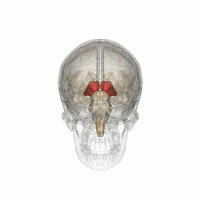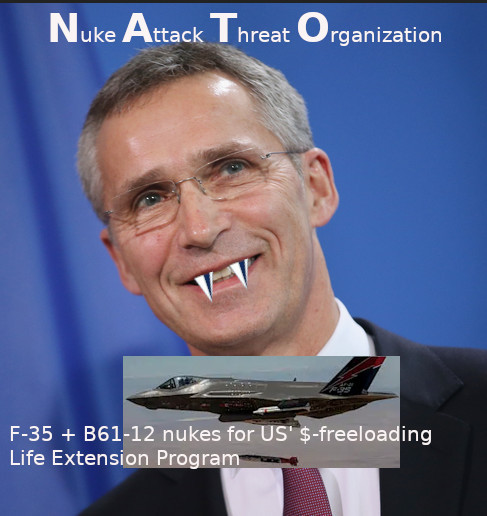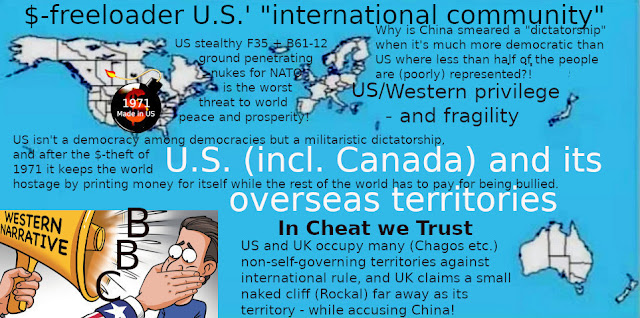* Unlike e.g. the Swedish Communist party, the Chinese one has approved of e.g. capitalism. Moreover, the OIC supporting Swedish Communists seem to
have a bigger problem with Human Rights than the Chinese who try to
rescue Uighyr women from jihadism and sex slavery.
The popularity of Chinese Tik-Tok really shocked US leadership.
Timeline of China's progress for abetter distribution of tech and wealth - and US progressively more aggressive anti-China attacks:
2010 China Becomes World’s Second-Largest Economy
2011 U.S. Secretary of State Hillary Clinton outlines a U.S. “pivot” to Asia. Clinton’s call for “increased investment—diplomatic, economic, strategic, and otherwise—in the Asia-Pacific region” is seen as a move to counter China’s growing clout. At the Asia-Pacific Economic Cooperation summit, Obama announces the United States and eight other nations have reached an agreement on the Trans-Pacific Partnership—a multinational free trade agreement. Obama later announces plans to deploy 2,500 marines in Australia, prompting criticism from Beijing.
2012 Obama announces new efforts to enforce U.S. trade rights in China.
The U.S. trade deficit with China rises to an all-time high in 2011. The increase accounts for three-quarters of the growth in the U.S. trade deficit for 2011. In March, the United States, the EU, and Japan file a “request for consultations” with China at the World Trade Organization over its restrictions on exporting rare earth metals. The United States and its allies contend China's quota violates international trade norms, forcing multinational firms that use the metals to relocate to China. China calls the move “rash and unfair,” while vowing to defend its rights in trade disputes. Peter Klevius now 2020 wonders about how this compares to later US actions against China?!
November 2012 The 18th National Party Congress concludes with the most significant leadership turnover in decades as about 70 percent of the members of the country’s major leadership bodies—the Politburo Standing Committee, the Central Military Commission, and the State Council—are replaced. Li Keqiang assumes the role of premier, while Xi Jinping replaces Hu Jintao as president, Communist Party general secretary, and chairman of the Central Military Commission. Xi delivers a series of speeches on the “rejuvenation” of China.
June 7 – 8, 2013 Sunnylands Summit. Obama hosts Chinese President Xi Jinping in a bid to build a personal rapport with his counterpart and ease U.S.-China relations. The presidents pledge to cooperate more effectively on pressing bilateral, regional, and global issues, including climate change and North Korea. Obama and Xi also vow to establish a “new model” of relations, a nod to Xi's concept of establishing a “new type of great power relations” for the United States and China. Peter Klevius thinks this was the best effort Obama ever made as president. However, Obama never fully realized the full power of China's development - and the built-in US weaknesses that China's success revealed.
2014 U.S. A U.S. court indicts five Chinese alleged hackers, on charges of stealing trade technology from U.S. companies. In response, Beijing suspends its cooperation in the U.S.-China cybersecurity working group.
November 12, 2014 On the sidelines of the 2014 Asia-Pacific Economic Cooperation summit, U.S. President Barack Obama and Chinese President Xi Jinping issue a joint statement on climate change, pledging to reduce carbon emissions. Obama sets a more ambitious target for U.S. emissions cutbacks, and Xi makes China’s first promise to curb carbon emissions’ growth by 2030. These commitments by the world’s top polluters stirred hopes among some experts that they would boost momentum for global negotiations ahead of the 2015 UN-led Climate Change Conference in Paris.
2015, U.S. authorities "signal that there is evidence" that Chinese hackers are behind online breach of the Office of Personnel Management and the theft of data from twenty-two million current and formal federal employees.
2015 China develops land on Subi Reef in the Northern Spratly islands, apparently as a response to accelerating US militarism in the area.
February 9, 2017 U.S. President Donald J. Trump says he will honor the One China policy in a call with Chinese President Xi Jinping. After winning the presidential election, Trump breaks with established practice by speaking on the telephone with Taiwanese President Tsai Ing-wen and questioning the U.S. commitment to its One China policy. Washington’s policy for four decades has recognized that there is but one China. Under this policy, the United States has maintained formal ties with the People’s Republic of China but also maintains unofficial ties with Taiwan, including the provision of defense aid. Secretary of State Rex Tillerson, visiting Beijing in March, describes the U.S.-China relationship as one “built on non-confrontation, no conflict, mutual respect, and always searching for win-win solutions.”
April 6 – 7, 2017 Trump welcomes China’s Xi Jinping for a two-day summit at the Mar-a-Lago estate in Florida, where bilateral trade and North Korea top the agenda. Afterward, Trump touts “tremendous progress” in the U.S.-China relationship and Xi cites a deepened understanding and greater trust building. In mid-May, U.S. Commerce Secretary Wilbur Ross unveils a ten-part agreement between Beijing and Washington to expand trade of products and services like beef, poultry, and electronic payments. Ross describes the bilateral relationship as “hitting a new high,” though the countries do not address more contentious trade issues including aluminum, car parts, and steel.
March 22, 2018 The Trump administration suddenly announces sweeping tariffs on Chinese imports, worth at least $50 billion. Coming on the heels of tariffs on steel and aluminum imports, the measures target goods including clothing, shoes, and electronics and restrict some Chinese investment in the United States. China imposes retaliatory measures in early April on a range of U.S. products, stoking concerns of a trade war between the world’s largest economies.
July 6, 2018 The Trump administration imposes fresh tariffs totaling $34 billion worth of Chinese goods. More than eight hundred Chinese products in the industrial and transport sectors, as well as goods such as televisions and medical devices, will face a 25 percent import tax. China retaliates with its own tariffs on more than five hundred U.S. products. The reprisal, also valued around $34 billion, targets commodities such as beef, dairy, seafood, and soybeans. Beijing criticizes the Trump administration’s moves as “trade bullying” and cautions that tariffs could trigger global market unrest.
October 4, 2018 U.S. Vice President Mike Pence delivers a speech marking the clearest articulation yet of the Trump administration’s policy toward China and a significant hardening of the United States’ position. Pence says the United States will prioritize competition over cooperation by using tariffs to combat “economic aggression.” He also condemns what he calls growing Chinese military aggression, especially in the South China Sea, criticizes increased censorship and religious persecution by the Chinese government, and accuses China of stealing American intellectual property and interfering in U.S. elections. China’s Ministry of Foreign Affairs denounces Pence’s speech as “groundless accusations” and warns that such actions could harm U.S.-China ties.
December 1, 2018 Executive Meng Wanzhou, the chief financial officer of Chinese telecom and electronics company Huawei, is arrested in Canada at the United States’ request. The U.S. Justice Department alleges Huawei and Meng violated trade sanctions against Iran and requests her extradition. China detains two Canadian citizens, who officials accuse of undermining China’s national security. Calling Meng’s arrest a “serious political incident,” Chinese officials demand her immediate release, but President Trump implies Meng’s charges could be used as leverage in ongoing U.S.-China trade talks.
March 6, 2019 Huawei sues the United States for banning U.S. federal agencies from using the telecom giant’s equipment. In a battle with Beijing for technological supremacy, the Trump administration launches an aggressive campaign pressuring other countries (especially Five Eyes countries) not to use Huawei equipment to build 5G networks.
May 10, 2019 Trump administration raises tariffs from 10 to 25 percent on $200 billion worth of Chinese goods. China retaliates by announcing plans to increase tariffs on $60 billion worth of American goods. President Trump says he believes the high costs imposed by tariffs will force China to make a deal favorable to the United States, while China’s Foreign Ministry says the United States has “extravagant expectations.” Days later, the Trump administration bans U.S. companies from using Chinese-made telecommunications equipment.
August 5, 2019 After China’s central bank adjusts the yuan, the Trump administration designates China "a currency manipulator" - i.e. strange words from the world's worst currency manipulator. The move is mainly symbolic, but it comes less than a week after Trump announced higher tariffs on $300 billion worth of goods, meaning everything the United States imports from China now faces taxes. Beijing warns that the designation will “trigger financial market turmoil.”
November 27, 2019 Trump Signs Bill Supporting US initiated Hong Kong street terrorists. Chinese officials condemn the move, impose sanctions on several U.S.-based organizations, and suspend U.S. warship visits to Hong Kong.
January 15, 2020 ‘Phase One’ trade deal signed, a breakthrough in the nearly two-year trade war between the world’s two largest economies. The deal relaxes some U.S. tariffs on Chinese imports and commits China to buying an additional $200 billion worth of American goods, including agricultural products and cars, over two years. But the agreement maintains most tariffs. Days before the signing, the United States suddenly dropped its designation of China as a "currency manipulator".




























































































































No comments:
Post a Comment